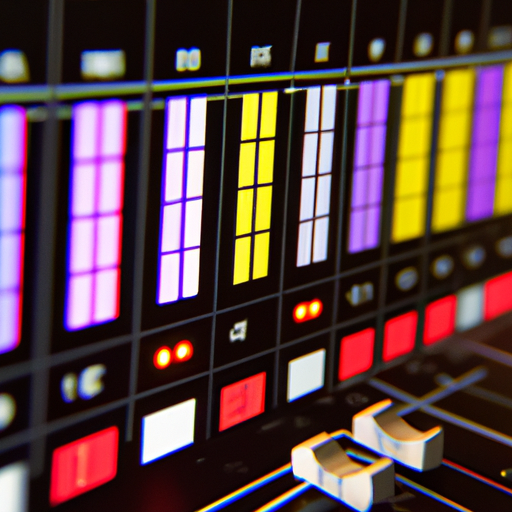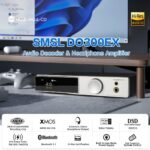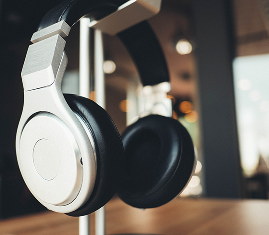So you want to take your audio playback to the next level? Look no further than mastering the art of EQ. EQ, or equalization, is a powerful tool that allows you to fine-tune the sound of your audio to suit your personal preferences. Whether you enjoy punchy bass, crisp vocals, or a balanced mix, understanding how to manipulate EQ can transform your listening experience. In this article, we’ll explore the ins and outs of EQ and give you the tips and tricks you need to master this essential audio technique. Get ready to unlock a world of tailored audio playback like never before.
Understanding the Concept of EQ
Definition of EQ in audio
In the world of audio, EQ stands for Equalization. It is a fundamental tool used to modify and shape the frequency response of audio signals. EQ allows you to adjust the balance and tonal quality of audio playback, enhancing certain frequencies while reducing others. It is a powerful tool that can greatly impact the overall sound and listening experience.
Role of EQ in audio playback
The role of EQ in audio playback is to ensure that the sound reproduction accurately represents the original intent of the audio content. It helps to address any deficiencies or imbalances caused by factors such as recording techniques, mixing processes, or room acoustics. By adjusting the frequency response, EQ helps to optimize the sound for different listening environments and personal preferences.
Significance of customizing EQ
Customizing EQ settings is significant because it allows you to tailor the audio playback according to your individual preferences and the characteristics of the audio content. Every individual has a unique hearing profile, and customizing EQ ensures that you are able to hear the audio in a way that is most pleasing to you. Furthermore, different types of audio content, such as music genres or movie soundtracks, may benefit from different EQ settings. Customization allows you to optimize the audio experience for each specific type of content.
The Basics of Sound Frequencies
Understanding hertz and decibel
Sound frequencies are measured in hertz (Hz), representing the number of cycles or vibrations per second. The human hearing range typically spans from 20 Hz to 20,000 Hz, although this range can vary among individuals. Decibel (dB) is the unit used to measure sound intensity or volume. It is a logarithmic scale, which means that each increase of 10 dB represents a tenfold increase in sound intensity. Understanding these basic units of measurement is crucial in comprehending the concept of EQ.
The nature of sound waves
Sound waves are disturbances that travel through a medium, such as air or water, to carry sound. They consist of alternating regions of high and low pressure, and their characteristics determine how we perceive sound. The frequency of a sound wave determines its pitch, with higher frequencies producing higher-pitched sounds and vice versa. The amplitude, or height, of a sound wave determines its volume or loudness.
The importance of frequency range in audio
The frequency range in audio refers to the span of frequencies that can be reproduced or captured by an audio system. It is crucial to understand the different frequency ranges because different instruments, voices, and audio effects occupy different ranges. By understanding the frequency range, you can use EQ to boost or cut specific frequencies, thereby creating a more balanced and accurate representation of the audio content.
In-depth Look at the Audio Spectrum
Breaking down the audio spectrum
The audio spectrum refers to the range of frequencies within the audible range. It is divided into different bands, each representing a specific range of frequencies. The audio spectrum is commonly divided into low-frequency (bass), mid-frequency (midrange), and high-frequency (treble). Understanding how the audio spectrum is divided allows you to identify which frequencies to focus on when making EQ adjustments.
Understanding the frequency bands
The different frequency bands within the audio spectrum have distinct characteristics and play different roles in audio quality. The low-frequency band (20 Hz – 250 Hz) is responsible for the bass and provides depth and impact to the sound. The mid-frequency band (250 Hz – 4 kHz) is where most of the musical instruments and vocal frequencies reside. The high-frequency band (4 kHz – 20 kHz) consists of the treble and contributes to the clarity and sparkle of the sound.
Role of each band in audio quality
Each frequency band plays a crucial role in audio quality. The low-frequency band provides the foundation and impact, enhancing the richness of bass-heavy content. The mid-frequency band adds warmth and presence to the audio, making vocals and instruments stand out. The high-frequency band adds clarity, detail, and brightness to the sound, ensuring that the audio is crisp and well-defined. By understanding the role of each band, you can effectively shape the overall tonal balance of the audio.
Recognizing EQ Controls on Audio Devices
Typical EQ parameters
Most EQ controls on audio devices consist of three primary parameters: gain, Q-factor, and frequency. The gain control allows you to boost or cut the level of a specific frequency. The Q-factor determines the width or bandwidth of the frequencies affected by the EQ adjustment. The frequency control enables you to select the specific frequency that you want to boost or cut. By familiarizing yourself with these parameters, you can effectively manipulate the audio to achieve your desired tonal balance.
Utilizing the gain, Q-factor, and frequency knobs
The gain knob allows you to adjust the level of a particular frequency band. You can increase or decrease the gain to boost or cut the selected frequency. The Q-factor knob controls the width of the frequency band affected by the EQ adjustment. A higher Q-factor narrows the bandwidth, focusing the effect on a narrower range of frequencies. The frequency knob determines the center point of the frequency band you wish to modify. By utilizing these knobs, you can precisely target and adjust different frequency ranges to shape the audio to your liking.
Identify the functions of other EQ controls
In addition to the primary EQ parameters, audio devices may have other EQ controls with specific functions. Some devices have a shelving EQ, which allows you to boost or cut frequencies above or below a certain point. Other devices may have a parametric EQ, which provides more precise control over frequency selection and adjustment. It is important to identify and understand the functions of these additional EQ controls to fully utilize the capabilities of your audio device.
Fundamentals of Equalization Techniques
Balancing sound frequencies
One of the fundamental techniques in EQ is balancing sound frequencies. This involves adjusting the level of different frequency bands to achieve a more even tonal balance. For example, if the bass frequencies are overpowering, you can reduce the gain in the low-frequency band to achieve a more balanced sound. By carefully balancing the sound frequencies, you can ensure that each frequency band is well-represented, resulting in a more pleasant and enjoyable audio experience.
Cutting and boosting frequency bands
Cutting and boosting frequency bands are techniques employed in EQ to address specific issues or enhance certain aspects of the audio. Cutting involves reducing the gain of a specific frequency band to reduce its dominance or to eliminate unwanted frequencies. Boosting, on the other hand, involves increasing the gain of a frequency band to bring out certain elements and make them more prominent. These techniques allow you to shape the audio to your liking and emphasize desired characteristics.
Avoiding common EQ mistakes
While EQ can significantly improve the audio quality, it is important to avoid common mistakes that can have a negative impact. One common mistake is excessive boosting or cutting, which can introduce unnatural and harsh-sounding artifacts. It is essential to make subtle adjustments and listen carefully to the changes. Another mistake is not considering the overall context and balance of the audio. It is crucial to analyze how the EQ adjustments affect the entire audio mix and ensure that the changes are consistent and complementary.
Using Graphic and Parametric EQ
Distinguishing graphic and parametric EQ
Graphic EQ and parametric EQ are two common types of EQ found in audio devices. Graphic EQ typically consists of a series of sliders that control the level of specific frequency bands. It provides a visual representation of the EQ adjustments and is suitable for making broad tonal changes. Parametric EQ, on the other hand, offers more precise control by allowing you to adjust gain, frequency, and Q-factor independently. It is more versatile and suitable for detailed and fine-tuned adjustments.
Best practices for using graphic EQ
When using a graphic EQ, it is important to keep a few best practices in mind. First, it is advisable to start with the sliders set at their neutral or center positions and make incremental adjustments based on your listening preferences. Second, avoid making drastic changes to multiple sliders simultaneously, as it can lead to unnatural and unbalanced sound. Finally, take the time to understand the specific frequency ranges of the sliders and how they relate to the overall audio spectrum to make more informed decisions.
Capitalizing on the benefits of parametric EQ
Parametric EQ offers greater control and flexibility compared to graphic EQ. To capitalize on its benefits, it is important to understand the interaction between the gain, frequency, and Q-factor. Start by identifying the specific frequencies that require adjustment, then fine-tune the gain, frequency, and Q-factor to achieve the desired result. Experimenting with different settings and listening critically to the changes will help you achieve a more tailored and personalized audio playback.
Tools and Software for Audio Equalization
Essential hardware for EQ
To effectively utilize EQ, there are some essential hardware components that you may need. A reliable audio interface that connects your audio source to your computer or speakers is crucial. Quality studio monitors or headphones are also necessary to accurately hear and monitor the changes made through EQ. Additionally, a digital audio workstation (DAW) can provide a comprehensive platform for EQ and other audio processing tasks. Investing in these hardware components will enhance your EQ experience and ensure optimal audio quality.
Top software for digital equalization
There are various software applications available that offer powerful digital equalization capabilities. Some popular options include Adobe Audition, Avid Pro Tools, Ableton Live, and Steinberg Cubase. These software programs provide a wide range of EQ tools and features, allowing you to make precise and detailed adjustments to your audio content. It is important to explore different software options and choose one that best suits your needs, workflow, and level of expertise.
Choosing the right EQ tool or software
Selecting the right EQ tool or software depends on various factors, such as your budget, level of expertise, and specific requirements. It is essential to consider the capabilities and features offered by different EQ tools or software. Look for tools that provide a user-friendly interface, flexible parametric EQ controls, and the ability to customize and save EQ presets. Reading reviews, seeking recommendations from professionals, and testing out trial versions can help you make an informed decision.
Advanced EQ Techniques for Personalized Sound
Creating custom EQ settings
Creating custom EQ settings allows you to personalize the audio playback to your specific preferences. Experiment with different EQ adjustments and observe how they impact the overall sound. Take note of the frequencies that enhance or detract from the audio and adjust accordingly. By engaging in a trial-and-error process, you can create custom EQ settings that cater to your unique listening preferences and optimize the audio experience for your ears.
Tips to tailor EQ for different genres
Different music genres have characteristic frequency profiles and tonal qualities. Tailoring EQ settings to match different genres can help enhance the audio experience and bring out the best in the music. For example, in a bass-heavy EDM track, emphasizing the low-frequency band can add impact and energy. On the other hand, in a jazz recording, focusing on the mid-frequency band can bring clarity to the instrumental performances. Understanding the specific sonic characteristics of different genres and making genre-specific adjustments can greatly enhance the audio playback.
Best practices for ‘finishing’ an audio mix
EQ is an essential tool for ‘finishing’ an audio mix, ensuring that all the elements come together cohesively and harmoniously. When finishing an audio mix, it is important to carefully balance the different tracks and instruments through EQ adjustments. Take the time to critically listen to the individual tracks and assess how they interact with each other. Make subtle EQ adjustments to enhance the clarity and separation of the instruments, thereby creating a polished and professional audio mix.
Role of EQ in Addressing Room Acoustics
Understanding room acoustics
Room acoustics refers to the characteristics of a room that influence the way sound behaves within it. Factors such as room size, shape, and construction materials can greatly impact the audio playback. Understanding room acoustics is important because it affects how certain frequencies are absorbed or reflected within the space. EQ can be used to compensate for room-related acoustic issues and optimize the audio playback in different listening environments.
How EQ tunes room acoustics
EQ can effectively address room acoustics by compensating for the natural frequency response of the room. By making adjustments to the EQ settings, you can counteract any resonances or dips caused by room modes or standing waves. For example, if a room tends to emphasize certain bass frequencies, you can reduce the gain in that frequency range to achieve a more balanced and accurate representation of the audio. EQ allows you to tailor the audio to the specific characteristics of the room and overcome any acoustic challenges.
Dealing with common room acoustic issues
Common room acoustic issues include excessive bass buildup, flutter echoes, or excessive reflections. EQ can help address these issues by adjusting the frequency response. For excessive bass buildup, you can reduce the gain in the low-frequency range. Flutter echoes can be mitigated by targeting the mid-frequency range and reducing its gain. Excessive reflections can be minimized by reducing the gain in the problematic frequency bands. By identifying and addressing these common room acoustic issues through EQ, you can achieve a more enjoyable and accurate audio playback.
Maintaining Audio Integrity with EQ
Ensuring clarity and presence
One of the key objectives of EQ is to ensure clarity and presence in the audio playback. By carefully adjusting the frequency response, you can enhance the intelligibility of vocals and instruments, making them more distinct and clear. EQ allows you to reduce any muddiness or masking caused by overlapping frequencies, resulting in a more defined and articulate sound. By prioritizing clarity and presence, you can ensure that every element in the audio mix is heard with precision and accuracy.
Maintaining balance and dynamic range
Another important aspect of using EQ is maintaining balance and dynamic range. EQ adjustments should strive to create a balanced representation of the audio content, where no frequency band overpowers or dominates the others. By ensuring a balanced frequency response, you can preserve the natural timbre and tonal qualities of the audio. Additionally, EQ can help preserve the dynamic range, allowing the audio to have the appropriate peaks and valleys, ensuring that the music or sound effects have the desired impact and emotion.
Preserving the original feel of the audio
While EQ is a powerful tool, it is crucial to ensure that it does not alter the original feel and intention of the audio. The goal of EQ is to enhance the audio playback, not to radically transform it. It is important to approach EQ adjustments with a careful and discerning ear, continuously referencing the original audio and critically listening to the changes. By preserving the original feel of the audio, you can maintain the artistic integrity and authenticity of the content.
In conclusion, mastering the art of EQ is essential for achieving tailored audio playback. Understanding the concept of EQ, the basics of sound frequencies, and the in-depth look at the audio spectrum provide a solid foundation. Recognizing EQ controls, utilizing different EQ techniques, and using graphic and parametric EQ effectively allows for personalized sound. Additionally, being aware of the role of EQ in addressing room acoustics, maintaining audio integrity, and preserving the original feel of the audio ensures optimal audio quality. With the right tools and software, advanced EQ techniques, and knowledge of different genres, EQ becomes a powerful tool for creating an immersive and enjoyable audio experience. So dive into the world of EQ, experiment, and refine your skills to unlock the true potential of audio playback.










